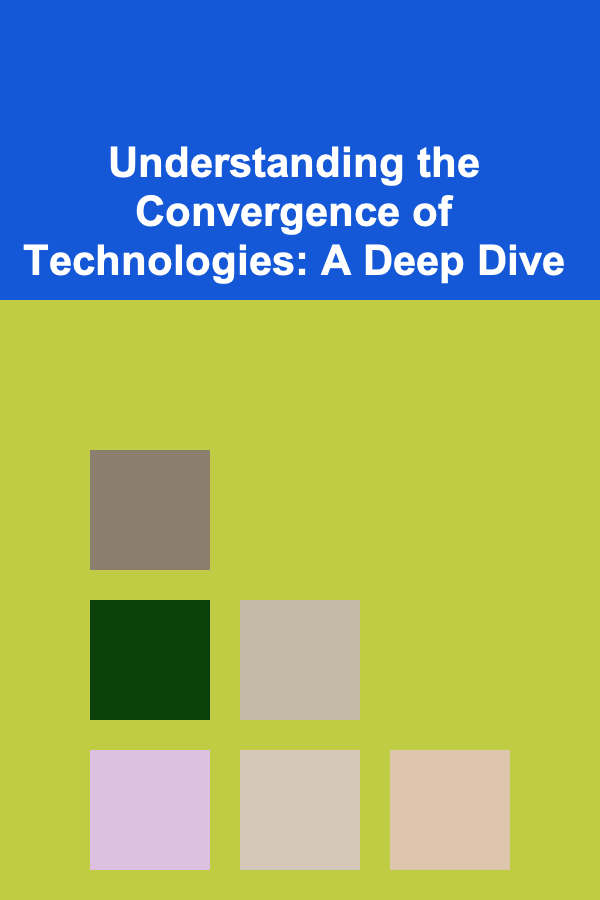
Understanding the Convergence of Technologies: A Deep Dive
ebook include PDF & Audio bundle (Micro Guide)
$12.99$11.99
Limited Time Offer! Order within the next:

The world around us is changing at an unprecedented pace, driven by advancements in various technological fields. However, it's not just the individual advancements that are significant; it's the convergence of these technologies that is truly transformative. Understanding this convergence is crucial for businesses, policymakers, researchers, and individuals alike to navigate the complexities of the modern world and capitalize on emerging opportunities. This essay will explore the concept of technological convergence, examining its underlying drivers, different forms, profound implications, and strategies for comprehending and adapting to its ever-evolving nature.
What is Technological Convergence?
At its core, technological convergence refers to the merging of distinct technologies into new, integrated platforms, functionalities, and products. It represents a blurring of the lines between previously separate technological domains, resulting in innovative solutions that are often more powerful, efficient, and versatile than their individual components. Think of it as a synergistic relationship where the whole is greater than the sum of its parts.
A simple example is the smartphone. It represents the convergence of mobile telephony, internet access, digital photography, navigation, and countless other functionalities into a single, handheld device. Before smartphones, these functions required separate devices. The convergence has not only simplified our lives but also fostered new industries and altered the very fabric of social interaction.
The Drivers of Technological Convergence
Several key factors contribute to the acceleration of technological convergence:
- Digitalization: The increasing digitization of information and processes is perhaps the most fundamental driver. Converting analog data into digital formats allows for easier storage, transmission, manipulation, and integration across different systems.
- The Internet and Network Effects: The internet provides a common platform for connecting disparate technologies and facilitating data exchange. The more devices and applications that connect to the internet, the greater the network effect, leading to further innovation and convergence.
- Cloud Computing: Cloud computing provides scalable and accessible computing resources, enabling companies to develop and deploy applications that leverage data and services from multiple sources. This removes the need for extensive in-house infrastructure and facilitates collaboration.
- Advancements in Artificial Intelligence (AI): AI, particularly machine learning, enables systems to learn from data and automate tasks. This allows for the integration of AI capabilities into existing technologies, enhancing their functionality and creating new possibilities. For instance, AI is being integrated into healthcare devices for diagnostics and personalized treatment.
- Miniaturization and Material Science: Advancements in miniaturization, particularly in microelectronics and nanotechnology, allow for packing more functionality into smaller devices. Simultaneously, new materials are enabling the creation of more durable, efficient, and versatile components.
- Software as a Service (SaaS): The shift towards SaaS models allows users to access software applications over the internet, rather than installing them on their own devices. This facilitates integration between different software platforms and reduces the cost and complexity of software deployment.
- Open Source Software: Open source software encourages collaboration and sharing of code, accelerating innovation and facilitating the integration of different technologies.
- Economic Incentives: Companies are constantly seeking new ways to create value and gain a competitive advantage. Technological convergence provides opportunities to develop innovative products and services that can address unmet needs and generate new revenue streams.
- Increased Computing Power: Moore's Law, although slowing, still illustrates the dramatic increase in computing power over time. This allows for more complex algorithms and data processing, facilitating the integration of different technologies.
- Standardization: The development and adoption of industry standards facilitates interoperability between different technologies, making it easier to integrate them into new systems.
Forms of Technological Convergence
Technological convergence manifests itself in various forms, each with its own unique characteristics and implications:
- Media Convergence: This involves the merging of different forms of media, such as text, audio, and video, into a single platform. The internet and mobile devices have been instrumental in driving media convergence, allowing users to access a wide range of content on a single device. Examples include streaming services like Netflix and Spotify, which combine video and audio content delivery.
- Communication Convergence: This refers to the integration of different communication technologies, such as voice, data, and video, into a unified network. VoIP (Voice over Internet Protocol) is a prime example, allowing users to make phone calls over the internet.
- Data Convergence: This involves the integration of data from different sources into a single repository, enabling better analysis and decision-making. Big data analytics and data warehousing are key components of data convergence.
- Computing and Telecommunications Convergence: This refers to the merging of computing and telecommunications technologies, leading to the development of new devices and services, such as smartphones and cloud computing.
- Content and Communication Convergence: This combines the creation and distribution of content with communication technologies. Social media platforms like Facebook and Twitter exemplify this type of convergence, allowing users to create and share content with their networks.
- Industry Convergence: This involves the blurring of boundaries between different industries as technologies become more integrated. For example, the automotive industry is converging with the technology industry, as cars become increasingly connected and autonomous.
Implications of Technological Convergence
The implications of technological convergence are far-reaching and impact various aspects of society:
- Economic Transformation: Convergence can lead to the creation of new industries and business models, while also disrupting existing ones. Companies need to adapt to these changes to remain competitive. Think of how the rise of e-commerce has transformed the retail industry.
- Social and Cultural Impacts: Convergence can influence how people communicate, interact, and consume information. Social media, for example, has transformed social interactions and political discourse. The spread of misinformation and the erosion of privacy are also significant concerns.
- Political and Regulatory Challenges: Convergence raises new challenges for policymakers and regulators, as existing laws and regulations may not be adequate to address the complexities of integrated technologies. Issues such as data privacy, cybersecurity, and intellectual property require careful consideration.
- Increased Efficiency and Productivity: By streamlining processes and automating tasks, convergence can lead to significant gains in efficiency and productivity. This can benefit businesses, governments, and individuals.
- New Opportunities for Innovation: Convergence creates new possibilities for innovation by combining different technologies in novel ways. This can lead to the development of groundbreaking products and services.
- Democratization of Technology: Convergence can make technology more accessible and affordable, empowering individuals and communities. The widespread adoption of smartphones, for example, has given billions of people access to information and communication tools.
- Ethical Considerations: As technologies converge and become more powerful, it is important to consider the ethical implications. Issues such as bias in AI algorithms, the impact of automation on employment, and the potential for misuse of technology require careful consideration.
- Security Risks: The increasing interconnectedness of technologies also creates new security risks. Cyberattacks can disrupt critical infrastructure, steal sensitive data, and cause widespread damage.
Strategies for Understanding Technological Convergence
Given the complexity and dynamism of technological convergence, it's essential to develop effective strategies for understanding and navigating its impact. Here are some key approaches:
- Continuous Learning: The technological landscape is constantly evolving, so it's crucial to stay informed about the latest advancements in various fields. This involves reading industry publications, attending conferences, taking online courses, and engaging with experts. Don't just focus on your specific field; broaden your knowledge to related areas.
- Interdisciplinary Thinking: Convergence often involves the integration of technologies from different disciplines. Cultivating an interdisciplinary mindset allows you to identify opportunities for collaboration and innovation that might otherwise be missed. Seek out perspectives from individuals with diverse backgrounds and expertise.
- Scenario Planning: Develop scenarios of how different technologies might converge in the future and the potential implications of these convergences. This can help you anticipate future trends and prepare for potential disruptions. Consider both optimistic and pessimistic scenarios.
- Networking and Collaboration: Engage with other professionals in your field and related fields to share knowledge and identify opportunities for collaboration. Attend industry events, join professional organizations, and participate in online communities. Building a strong network can provide valuable insights and connections.
- Experimentation and Prototyping: Don't be afraid to experiment with new technologies and develop prototypes to test their potential applications. This can help you gain a deeper understanding of how different technologies can be integrated and identify potential challenges and opportunities.
- Focus on User Needs: Ultimately, the success of any technology depends on its ability to meet the needs of users. When considering the potential of technological convergence, always keep the user experience in mind. Focus on developing solutions that are user-friendly, accessible, and valuable.
- Analyze Industry Trends: Pay close attention to industry trends and emerging technologies. This can help you identify potential areas of convergence and understand how different industries are evolving. Read industry reports, follow leading companies, and track venture capital investments.
- Embrace a Systems Thinking Approach: Understand that technological systems are complex and interconnected. Changes in one area can have ripple effects throughout the entire system. A systems thinking approach helps you to consider the broader implications of technological convergence.
- Develop a Strategic Vision: Based on your understanding of technological convergence, develop a strategic vision for your organization or your career. This vision should outline how you will leverage convergence to achieve your goals and stay ahead of the curve. Be prepared to adapt your vision as the technological landscape evolves.
- Data Analytics and Visualization: Utilize data analytics tools to identify patterns and trends in data related to technology adoption and convergence. Visualize this data to communicate insights effectively and identify emerging opportunities.
Examples of Ongoing and Future Convergence
Let's explore some specific examples of technological convergence happening right now and those on the horizon:
- Healthcare and AI: AI is being integrated into medical devices for diagnostics, personalized treatment plans, and drug discovery. Machine learning algorithms can analyze medical images, predict patient outcomes, and personalize medication dosages. This convergence promises to revolutionize healthcare, making it more efficient, effective, and accessible.
- Agriculture and IoT: The Internet of Things (IoT) is transforming agriculture by connecting sensors, drones, and other devices to collect data on soil conditions, weather patterns, and crop health. This data is then used to optimize irrigation, fertilization, and pest control, leading to increased yields and reduced waste. Precision agriculture is a key beneficiary of this convergence.
- Transportation and Autonomous Systems: The development of self-driving cars is a prime example of convergence, bringing together technologies such as AI, computer vision, sensors, and robotics. This convergence has the potential to revolutionize transportation, making it safer, more efficient, and more sustainable.
- Finance and Blockchain: Blockchain technology is being integrated into the financial industry to improve security, transparency, and efficiency. Cryptocurrencies, smart contracts, and decentralized finance (DeFi) are all examples of this convergence. Blockchain has the potential to disrupt traditional financial institutions and create new opportunities for financial innovation.
- Education and Virtual Reality (VR): VR is being used to create immersive learning experiences, allowing students to explore historical sites, conduct virtual experiments, and interact with 3D models. This convergence promises to make education more engaging, effective, and accessible.
- Manufacturing and 3D Printing: 3D printing is revolutionizing manufacturing by allowing companies to create complex parts and products on demand. This convergence enables rapid prototyping, mass customization, and distributed manufacturing. It's transforming supply chains and empowering small businesses.
- Energy and Smart Grids: Smart grids integrate digital technologies into the energy infrastructure to improve efficiency, reliability, and sustainability. This convergence enables real-time monitoring of energy consumption, optimized distribution, and integration of renewable energy sources.
- Retail and Augmented Reality (AR): AR is being used to enhance the retail experience, allowing customers to virtually try on clothes, visualize furniture in their homes, and access product information in real-time. This convergence promises to make shopping more engaging, convenient, and personalized.
Conclusion
Technological convergence is a powerful force that is reshaping the world around us. Understanding its drivers, forms, and implications is essential for navigating the complexities of the modern world and capitalizing on emerging opportunities. By embracing continuous learning, interdisciplinary thinking, and strategic planning, we can harness the potential of technological convergence to create a more prosperous, equitable, and sustainable future. The key is to not just be aware of the changes, but to actively participate in shaping the direction of this convergence, ensuring that it benefits all of humanity. The future belongs to those who can understand, adapt to, and innovate within this ever-evolving landscape.

Effective Strategies for Medical Researchers: From Hypothesis to Breakthrough
Read More
How to Make a Checklist for Safety Inspections in Laboratories
Read More
How to Organize Your Entryway for Maximum Space Efficiency
Read More
The Art of Advocacy: Effective Communication and Engagement Strategies for Customer Success Managers
Read More
How to Cook Healthy Meals for Kids
Read More
Understanding and Completing Form 1040: A Beginner's Guide
Read MoreOther Products

Effective Strategies for Medical Researchers: From Hypothesis to Breakthrough
Read More
How to Make a Checklist for Safety Inspections in Laboratories
Read More
How to Organize Your Entryway for Maximum Space Efficiency
Read More
The Art of Advocacy: Effective Communication and Engagement Strategies for Customer Success Managers
Read More
How to Cook Healthy Meals for Kids
Read More